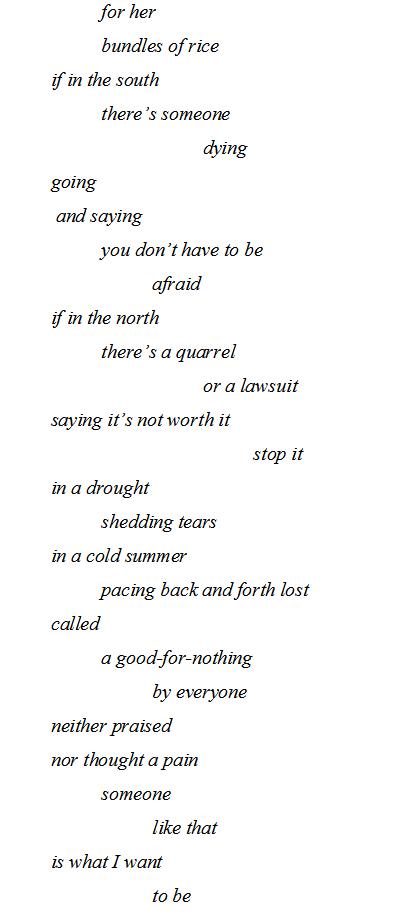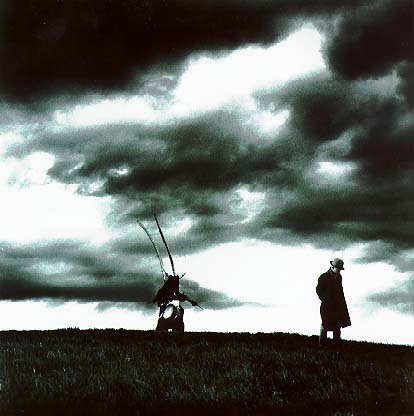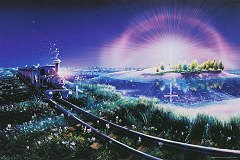Hiroaki SATO
Do they still require schoolchildren to memorize Miyazawa Kenji’s poem Ame ni mo makezu? I ask my young friend Donald Howard who is teaching English in Iwate, where his wife Saori is from. Donald and Saori had also visited the Miyazawa Memorial Museum for me a few years earlier, when they still lived in New York, and brought back a CD of Kenji’s musical compositions orchestrated and sung. After checking with a couple of teachers, Donald responds: Yes, they do.
I asked because, though I myself do not remember ever being required to memorize the poem in school during the 1950s, I’ve learned the requirement was in force in some places, at various times. And if it still is, it must be in Iwate, I thought, where Kenji was born, in 1896, grew up, spent most of his life, and died, in 1933. I learned, years ago, its extracurricular popularity, as it were: it appears on all sorts of souvenirs – towels, mugs, fans, etc. – made and sold in Iwate, especially in Hanamaki, Kenji’s birthplace. It is also, I learned, the most revered poem in twentieth-century Japan.
Nonetheless, when I had the first opportunity to translate a group of Kenji’s poems into English for publication, the translations later gathered in Spring & Asura: Poems of Kenji Miyazawa (Chicago Review Press, 1973), I did not include Ame ni mo makezu in my selection. Why? I’ve since wondered, from time to time.
Was I intimidated by its fame? Or was I put off by it? Or, finding myself in New York in the last phase of the Hippie Era, did I decide that the kind of sentiment expressed in the poem was “out”? Or did I take the hint from Gary Snyder’s non-inclusion of it in the group of Kenji’s poems he translated and made part of The Back Country (New Directions, 1967)?
Thirty-five-year old memories can play funny tricks. I clearly remember some of the fun-filled, inspiring evenings I spent with the poet Michael O’Brien on Kenji: how, each time I had worked out half a dozen translations, I’d take them to his fifth-floor walk-up apartment on 123rd Street; how he’d not just rectify my miserable and worthless English over beer but come up with sparkling phrases to replace my amorphous approximations, drawing pictures on the typescripts to make sure I was getting his point when necessary (why didn’t I preserve those sheets for posterity or, even better, for a well-endowed, maniacal library archivist!); and so on.
As a translator, in retrospect, I’d like to think I was intimidated, if I was, not by the fame of the poem so much as by my inability to find a readily acceptable English word for the common Japanese verb makeru as used in the opening of the poem to create a refrain of sorts. Following Kenji’s writing, in lineation and spacing, as he scribbled it in a notebook when he was laid up ill, two years before his death from tuberculosis, the opening may be transcribed:

The difficulty of properly translating the word makeru – makezu, as well as makenu, is the negative form of the same word – may be discerned from the following attempts.
Bending neither to the rain
Nor to the wind
Nor to snow nor to summer heat,
Firm in body, yet
The Penguin Book of Japanese Verse, 1964
Neither rain
nor wind
nor snow nor summer’s heat
will affect his robust body. . . .
Modern Japanese Writers and the Nature of Literature, 1982
Undaunted by the rain,
Undaunted by the wind,
Undaunted by the snow or the summer heat,
With a strong body
Dawn to the West, 1984
Strong in the rain
Strong in the wind
Strong against the summer heat and snow
He is healthy and robust
Kenji Miyazawa: Poems, 1997
Still, in the end, I did translate the poem when the second opportunity arose – as it did, seven, eight years after the first one, including it in an anthology of Japanese poetry, From the Country of Eight Islands (Comp. with Burton Watson, Doubleday Anchor, 1981). Here’s the result, which is unlikely to satisfy anyone:


Whatever the opening lines in various translations may suggest – Keene says his translation may make Miyazawa sound “Kiplingesque” – you may gather, from my unworthy attempt, that Ame ni mo makezu is an expression of a wish to help poor peasants unobtrusively, aware of his inability to do anything in drought or in a cold summer, a self-effacing prayer, in fact, for ineffectual altruism in a tone of quiet resignation. Then, when you learn that Iwate in Kenji’s days was frequently ravaged by crop failures and, also, that Kenji was a devout Buddhist, you may begin to see why the poem once prompted the noted philosopher Tanikawa Tetsuzo to declare that Miyazawa Kenji was the only Japanese man of letters since the Meiji Era before whose grave he would genuflect. Some even have called Kenji “a saint,” “an agricultural saint.”
For all that, if you go by this poem alone, you can misconstrue Kenji and much of his writings. This poem – which Kenji may have simply meant as a prayer and which in my books I prefer to call “November 3rd” in reference to the date given atop the first page of the notebook in which he scribbled it – is, if anything, atypical of his writings and beliefs, though I would not go so far as to say, as Keene does, “it is by no means one of Miyazawa’s best poems.”
First of all, Miyazawa Kenji was a Buddhist, yes, but his Buddhism was of a firebrand reinterpretation of the aggressive Nichiren-shu. He was an ardent follower of the Kokuchukai (The Pillar of the Nation Society) that was established by Tanaka Chigaku (1861-1939), a fervent Nichiren advocate who, among other things, devised the notion of hakko ichiu, “all countries under one roof,” which the Japanese government adopted as an international slogan, in 1940, to justify, some insist, its militarist expansion overseas. One can argue, without much difficulty, that such aggressive stances of Nichirenism put Japan’s history in early Showa out of whack – just as, you can say, the Christian Right has helped skew recent U.S. policy toward the Middle East. One author has gone whole hog and written a whole book condemning Kenji item by item, as it were, largely because of his involvement in the Kokuchukai.
As it happened, Kenji died in 1933, just about the time military expansionism of the kind Tanaka and his followers promoted began to lead Japan into serious trouble – and before militarism completely dominated national politics. Then, too, he had practically no chance to get involved in any such activity. Yet guilt by association remains a nagging question.
Second, Kenji regarded himself not as a retiring man of humility but as an asura (Sanskrit; shura or ashura in Japanese) – in one Buddhist hierarchy any of the class of “evil deities or spirits fond of fighting and quarrels who are constantly at war with various heavenly deities,” as a Buddhist scholar put it. So, in the title poem of his first (and only published) book of poems, Haru to Shura (Spring & Asura), he described himself thus:
how bitter, how blue is the anger!
At the bottom of the light in April’s atmospheric strata,
spitting, gnashing, pacing back and forth,
I am Asura incarnate
He went on to give the same title to the two manuscripts of poems that were left unpublished in his lifetime. So, at least in his own imagining, he was no self-effacing anything; instead he was a contentious demon battling with things that surrounded him.
Miyazawa Kenji was a passionate man. He strongly believed in the sanctity of all sentient beings, the one basic Buddhist tenet as he saw it, and became a radical vegetarian. Here’s how he described the conversion.
. . . In spring I stopped eating the bodies of living things. Nonetheless, the other day I ate several slices of tuna sashimi as a form of magic to “undertake” my “communication” with “society.” I also stirred a cup of chawanmushi with a spoon. If the fish, while being eaten, had stood behind me and watched, what would he have thought? “I gave up my only life and this person is eating my body as if it were something distasteful.” “He’s eating me in anger.” “He’s eating me out of desperation.” “He’s thinking of me and, while quietly savoring my fat with his tongue, praying, ‘Fish, you will come with me as my companion some day, won’t you?’“ “Damn! He’s eating my body!” Well, different fish would have had different thoughts. . . .
Suppose I were the fish, and suppose that not only I were being eaten but my father were being eaten, my mother were being eaten, and my sister were also being eaten. And suppose I were behind the people eating us, watching. “Oh, look, that man has torn apart my sibling with chopsticks. Talking to the person next to him, he swallowed her, thinking nothing of it. Just a few minutes ago her body was lying there, cold. Now she must be disintegrating in a pitch-dark place under the influence of mysterious enzymes. Our entire family have given up our precious lives that we value, we’ve sacrificed them, but we haven’t won a thimbleful of pity from these people.”
I must have been once a fish that was eaten. . . .
Similarly, once converted to the Nichiren-shu, he declared he’d follow Tanaka’s command to the end of the earth as his soldier. Though that did not come to pass, fortunately, he pursued science with equal passion and loved to display what he knew, which was considerable, so that one of his earliest readers was startled to note that Kenji “wrote poems with meteorology, mineralogy, botany, and geology.” That startlement remains more or less the same today with many readers. They say Kenji is hard to read.
What makes Miyazawa Kenji stand out, indeed, is that he was a man of science and religion in equal measure. In Ame ni mo makezu, he spoke of helplessness in the face of drought or a cold summer, but he did that not because he had surrendered to “Buddhist resignation” or because he did not think about the causes of either phenomenon. In one of the “children’s stories,” for example, he depicts a young survivor of a famine who goes on to become an assistant engineer and sacrifices himself in making a volcano erupt artificially to let carbon dioxide spew into the jet stream so the atmospheric temperature may rise and prevent the cold weather from occurring, causing crop failure. Today we know giant volcanic eruptions cool the atmosphere and that, even if Kenji had been right in some way, raising the atmospheric temperature artificially would be an absolute no-no in this day of global warming, which we know is largely manmade. Yet the beauty of Kenji’s story is undiminished.
Kenji was a nature worshipper. He was awestruck not just by the vast universe, but also by the pristine expanse and the varied topography of Japan’s largest prefecture (ken), Iwate. He was, at the same time, distressed by the enormity of the suffering of the peasantry in that unfortunate land. He wanted to do something about it but in the end he was crushed.
A little biography is in order.
Kenji, the first son of a locally well-to-do pawnbroker and dealer of secondhand clothes, studied at the Morioka Higher School for Agriculture and Forestry, which the Iwate government established to deal with the prefecture’s terrible agrarian conditions. Fortunately, the field of agriculture, which covered a range of scientific fields, suited Kenji. So, when he took up a teaching post at a small local agricultural school, he was assigned to cover fertilizers, agricultural production, produce, meteorology, chemistry, soils, and practical training in growing rice, in addition to algebra and English.
Kenji taught at the school for more than four years. It was while there that he brought out his book of poems Haru to Shura (Spring & Asura) at his expense, in April 1924, and his book of children’s stories, Chumon no oi Ryoriten (A Restaurant with Many Orders), also at his expense, in December of the same year. He then left his teaching job, to live like “a real peasant” and also to create and spread “agrarian culture.” But the “real peasant” part was perhaps no more than a rich man’s son’s phantom dream, except for all the many “fertilizer plans” he devised for the real peasants, for all the frenzied work he did for them, especially in 1927, when Iwate was struck by a huge snow storm in January and by a huge rainstorm in April, raising the prospect of another crop failure. As to the “agrarian culture” part, it was nipped by “the thought police,” which suspected socialist, if not communist, designs in what Kenji set out to do. They made a threatening move against his family.
In August 1928, just over two years after he set up house to dedicate himself to the betterment of peasant life, Kenji was struck down by a high fever. It was a serious recurrence of tuberculosis, the first symptom of which he had had ten years earlier. In 1931, when he thought he had recovered enough, he worked for about seven months for a peasant-turned-producer of powdered limestone as fertilizer, the use of the sedimentary rock that his professor at Morioka Higher School had advocated. But the work as advisor-cum-engineer-cum-salesman – the salesman’s role required him to lug around heavy trunks packed with samples of powdered limestone – wore him down, incapacitating him for the rest of his life.
Kenji died essentially a single-book poet known only to a clutch of admirers. But his fame started to grow exponentially after the first three-volume set of zenshu, “complete works,” was issued in 1934-1935. Since then one zenshu after another has followed, in an ever larger number of volumes, the latest consisting of 18, with one “supplementary” volume. Editors have found irresistible the fact that Kenji left his manuscripts in many stages of revision and, yes, messy.
In that process, Ame ni mo makezu, itself posthumously discovered, played a vital role.
First, in 1936, it was picked for an anthology of modern poets, then for another, in a series for the young, a selection of works by “the people who have exerted themselves for the progress of mankind.” In 1941 a professor of literature at Beijing University translated it into Chinese for his anthology of Japanese poetry, ancient and modern. A different translation into Chinese was made, apparently for a book for dissemination in Manchukuo, the nation Japan established in 1932. In 1942 the cultural division of the Taiseiyokusankai – the government-initiated nationwide patriotic association formed in October 1940 when the sense of the inevitability of war with the United States was mounting – included it in an anthology of patriotic poems. On September 20, 1944 – by then Japan’s war in the Pacific was becoming desperate –Tanikawa Tetsuzo, the aforementioned philosopher, did what he did, in a lecture at Tokyo Women’s College. His point was that his compatriots had to be prepared for self-sacrifice, self-effacement, and willingness to help others.
After Japan’s defeat the government made Ame ni mo makezu part of a school textbook in such a way that the avant-garde poet Yoshimasu Gozo, born in 1939, recalled in a recent essay what happened when he once botched a “choral reading” of the poem in class. The young teacher, his eyes flashing with anger, slapped him, and did not just make him stand in the corner but also stay after school. That was when Gozo was in third or fourth grade or in 1948 or 1949. I was in school not long afterward, and slapping still had years to go before it was banned. But I don’t recall hearing that anyone received that form of corporal punishment for failing to read Ame ni mo makezu in unison with others.
Hiroaki Sato has published over two dozen volumes of translations of Japanese poetry including Miyazawa Kenji: Selections (Poets for the Millennium). His and Burton Watson’s anthology, From the Country of Eight Islands, won the American P. E. N translation prize. He is a past president of the Haiku Society of America.
He wrote this article for Japan Focus. Posted on September 20, 2007.






